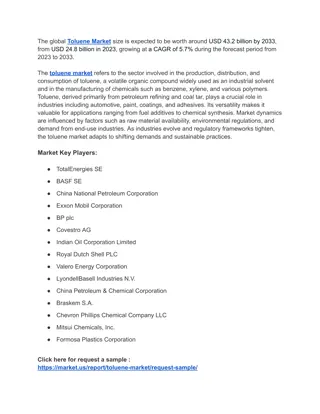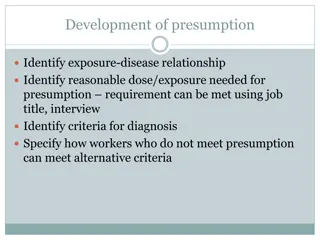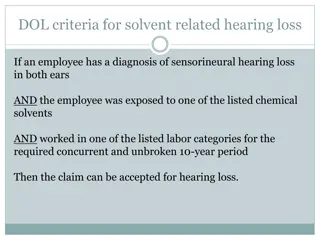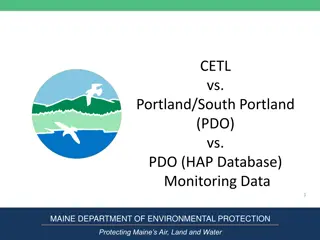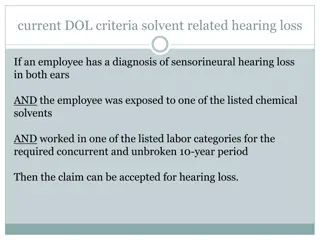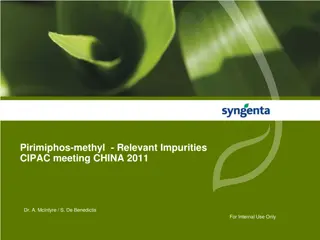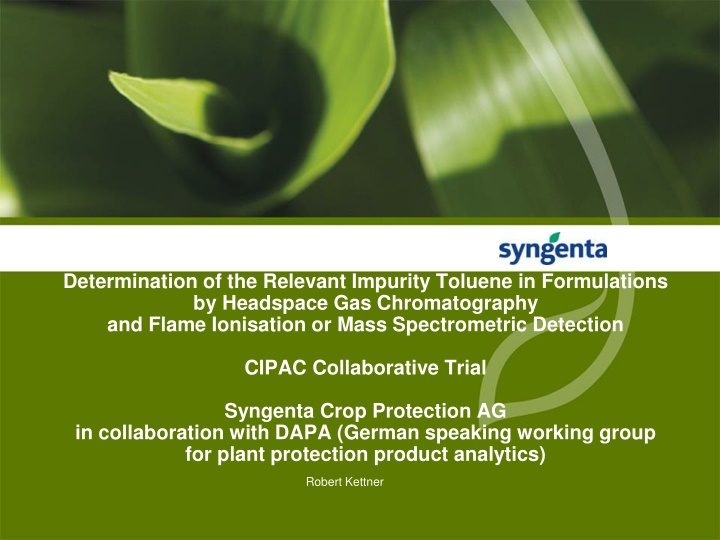
Determination of Relevant Toluene Impurity in Formulations - CIPAC Collaborative Trial
Learn about the method for determining the relevant impurity toluene in formulations using headspace gas chromatography and mass spectrometric detection. This method is crucial for meeting EU regulations on toluene content in active ingredients, ensuring product quality and safety. Explore the scope and principles of the method, as well as the benefits of headspace injection technique.
Download Presentation

Please find below an Image/Link to download the presentation.
The content on the website is provided AS IS for your information and personal use only. It may not be sold, licensed, or shared on other websites without obtaining consent from the author. If you encounter any issues during the download, it is possible that the publisher has removed the file from their server.
You are allowed to download the files provided on this website for personal or commercial use, subject to the condition that they are used lawfully. All files are the property of their respective owners.
The content on the website is provided AS IS for your information and personal use only. It may not be sold, licensed, or shared on other websites without obtaining consent from the author.
E N D
Presentation Transcript
Determination of the Relevant Impurity Toluene in Formulations by Headspace Gas Chromatography and Flame Ionisation or Mass Spectrometric Detection CIPAC Collaborative Trial Syngenta Crop Protection AG in collaboration with DAPA (German speaking working group for plant protection product analytics) Robert Kettner
Purpose of the Method In the EU, the content of Toluene as a relevant impurity is specified in several active ingredients (COMMISSION IMPLEMENTING REGULATION (EU) No 540/2011) Examples: 0.5 g Toluene / kg Metazachlor, 2 g Toluene / kg Azoxystrobin, 5 g Toluene / kg Difenoconazole, 5 g Toluene / kg Prothioconazole; Actual range 0.5 13 g Toluene / kg a.i. The manufacturers of the ai and the formulations have to submit a validated analytical method for each formulation/ai to the registration authorithies Goal: establish a method with universal applicability tested in a collaborative trial to determine the toluene content 2
Scope of Method The content of toluene as relevant impurity of the active ingredient is determined at low levels in solid formulated products and in water and organic solvent based liquid formulated products. The impurity toluene is measured in all different formulation types. The active ingredient does not interfere for this method. 3
Principle of Method The Toluene content of the samples is determined by headspace capillary gas chromatography (column with low-medium polarity stationary phase), helium carrier gas and flame ionisation or mass spectrometric detection. Standard addition method for quantification to compensate for matrix effects. Headspace instrumentation with an appropriate injection system - either a fixed transfer line to the GC or a gastight syringe (PAL-autosampler or equivalent). Benefits of Headspace Injection Technique: Only volatile components present in the sample get injected. Solids and high boiling liquids remain in the headspace vial and will not contaminate the GC column. 4 For Internal Use Only
Headspace GC-FID Autosampler Parameters, for fixed transfer line Headspace Sampler: Oven: Transfer Line: Equilibration time: Agilent 7694E 100 C 200 C 30 min 0.1 min 100 kPa 0.1 min Pressurize time: Pressure: Loop fill time: Loop equilibration time: 0.1 min Injection time: Loop injection volume: 1 ml Shake: 1 min low 5
Headspace GC-FID Chromatography Parameters Gas Chromatograph: Detector: Column: Agilent 6890A FID J&W DB-624, 30 m, 0.32 mm i.d., 1,8 m film Column temperature: Detector temperature: 300 C Injector temperature: Split ratio: Carrier gas: Make-up gas: 50 C, hold 2 min, 50 110 C heating rate 3 C/min, 110 240 C, heating rate 40 C/min, 2 min hold 220 C 20:1 Helium, 2.0 ml / minute (constant flow) Nitrogen, 30 ml / minute 6
Chromatograms Headspace GC-FID SC-formulation (Level 1) EC-formulation (Level 1) 7
PAL-Autosampler Parameters Gastight Syringe Incubation Temperature ( C) Incubation Time (s) Syringe Temperature ( C) Agitator Speed (rpm) Fill Speed (ul/s) Fill Strokes Pullup Delay (ms) Injection Speed (ul/s) Pre Inject Delay (ms) Post Inject Delay (ms) Flush Time (s) 100 1800 110 500 100 0 6000 500 500 500 90 8
GC-MS Parameter and Method Modifications SIM-mode at m/z 91 for toluene and ethylbenzene and at m/z 98 for D8- Toluene Full SCAN (e.g. m/z 30 260) with quantification at m/z 91 for toluene and ethylbenzene and at m/z 98 for D8-toluene Standard instrument parameters that are appropriate for the mass spectrometer instrument used Modifications: Adaptions of split ratio and/or injection volume DB-624 column can be replaced by a 5 % phenyl column (e.g. RTX-5, DB-5) when using MS-detection Deuterated Toluene instead of ethylbenzene as internal standard (MS) 9
Chromatograms Headspace GC-MS 08:20:59 PCH2014-012 1a 2 27-Mar-2014 SIR of 1 Channel EI+ SIM m/z 91 SC-formulation (Level 1) TIC 3.84 100 8.44e5 Ethylbenzene Toluene % 2.39 0 Time 1.50 2.00 2.50 3.00 3.50 4.00 4.50 5.00 5.50 6.00 23:49:11 PCH2014-010 1a 2 26-Mar-2014 SIR of 1 Channel EI+ SIM m/z 91 TIC 3.84 100 8.07e5 EC-formulation (Level 1) Ethylbenzene Toluene % 2.39 0 Time 1.50 2.00 2.50 3.00 3.50 4.00 4.50 5.00 5.50 6.00 10
Sample Preparation Reference substance: Toluene of known content Internal standard (IS): Ethylbenzene Solvent: Dimethylsulfoxide (DMSO), Headspace Quality Level Test solutions (2 of each level) 2.0 ml/ 2.0 ml 0 Sample DMSO/ IS solution 1 Sample spiked with solution A Solution A/ IS solution 2 Sample spiked with solution B Solution B/ IS solution 3 Sample spiked with solution C Solution C/ IS solution 4 Sample spiked with solution D Solution D/ IS solution 5 Sample spiked with solution E Solution E/ IS solution Sample weight: Sufficient amount of sample to contain 20 mg of active ingredient of interest. Total volume: 4 ml 11
Description of sample preparation Level 0 Level 1 Level 2 Level 3 Level 4 Level 5 no Toluene added, only internal standard (Ethylbenzene) 2.5 g Toluene / ml = 5 g Toluene / ml = 12.5 g Toluene / ml = 25 g Toluene / ml = 50 g Toluene / ml = 0.05% Toluene in relation to AI 0.10% Toluene in relation to AI 0.25% Toluene in relation to AI 0.50% Toluene in relation to AI 1.00% Toluene in relation to AI Sample weight: Sufficient amount of sample to contain 20 mg of active ingredient of interest. Total volume: 4 ml Level 0 Level 1 Level 2 Level 3 Level 4 Level 5 12
Participating Laboratories Country Name Organisation Switzerland Switzerland Germany Germany Germany Austria Netherlands Denmark Czech Rep. R. Kettner U. Schaller T. Bowen P. Wagener M. Haustein C. Czerwenka M. Bos E. Jacobsen O. Novakova Syngenta Crop Protection AG Agroscope Bayer Crop Science AG Bayer Crop Science AG Currenta GmbH & Co. OHG Austrian Agency for Health and Food Safety Cerexagri BV Danish Technological Institute Central Institute for Supervising and Testing in Agriculture, National Reference Lab. Wallon Agricultural Research Centre Syngenta Bioscience Pvt. Ltd. Jiangsu Rotam Chemistry Nutrichem Laboratory Co Ltd. Belgium India China China O. Pigeon S. Khot R. Joseph Y. Wang 13
Comments from the Labs Lab 4: Nitrogen instead of helium used as carrier gas. Recommendation to extend the time of the temperature programme (formulation EC2) Lab 5: Injection volume 500 l instead of 1000 l; chromatography shortened due to MS detection, toluene-d8 used as internal standard. MS detection in SIM mode: ions for toluene m/z = 91 (quantifier), 92 (qualifier 1), 65 (qualifier 2), ions for toluene-d8 m/z = 98. The data were also evaluated by external calibration (using the internal standard D8-toluene). The obtained results were comparable to those obtained by standard addition. Column: DB5, 30 m, 0.32 mm, film thickness 0.25 m Temp. program: 40 C for 7 min, 55 C/min ramp to 240 C, hold for 2 min. Detector temp.: 220 C Lab 6: Column: ZB-624, 60 m, 0.32 mm, film thickness 1.8 m; Split ratio: 15:1 Lab 8: Carrier gas: hydrogen, shaking time: 12 s, split ratio 5:1 Lab 9: Analysis also performed with MS detection 14
Comments from the Labs Lab 10: Column: BGB 5, 30 m, 0.32 mm, film thickness 0.25 m Temp. program: 50 C for 2 min, 3 C/min to 62 C, 40 C/min to 240 C, hold for 2 min. Detector temp.: 230 C Split ratio: 50:1 Lab 12: Column: DB-624, 30 m, 0.25 mm, film thickness 1.4 m Lab 13: Hold time of final column temperature increased to 5 min. 15
Test Items Formulation Type AI with Toluene EC 250 25 % w/w EC 400 18.2 % w/w ( total 2 ai) FS 480 41.5 % w/w SC 250 22.9 % w/w WG 50 50 % w/w 16
Techniques applied for toluene determination Autosampler Detector Fixed transfer line Gastight syringe FID MS 5 labs 8 labs 9 labs 4 labs 17
Results of a FS-Formulation Weight Toluene Ref Std 100mg Purity Toluene 99.9% Content of AI of interest in the formulation 41.50% w/w Level Toluol added [mg] Toluene added Sample Area Toluene Area IS Ratio Toluene/IS Ratio Toluene/IS corr. Ratio Toluene/IS Recovery [%] relative to AI [%] weight [mg] found found corr. calculated L0_1 0.000000 0.00 49.1 11.802 91.167 0.12945 -0.00040 0.00200 L0_2 0.000000 0.00 52.1 12.436 89.989 0.13819 0.00040 0.00200 L1_1 0.009990 0.05 53.8 25.584 86.487 0.29581 0.15353 0.15168 101.2 L1_1 0.009990 0.05 49.3 24.289 86.526 0.28071 0.15033 0.15168 99.1 L2_1 0.019980 0.10 51.3 38.355 86.881 0.44147 0.30580 0.30136 101.5 L2_2 0.019980 0.10 52.4 39.01 88.322 0.44168 0.30310 0.30136 100.6 L3_1 0.049950 0.24 49.9 77.471 88.326 0.87710 0.74513 0.75040 99.3 L3_2 0.049950 0.24 51.7 78.141 88.62 0.88175 0.74502 0.75040 99.3 L4_1 0.099900 0.48 53.7 143.598 87.318 1.64454 1.50252 1.49880 100.2 L4_2 0.099900 0.48 49.5 142.555 87.24 1.63406 1.50315 1.49880 100.3 L5_1 0.199800 0.95 49.7 272.636 87.085 3.13069 2.99925 2.99560 100.1 L5_2 0.199800 0.95 52.3 273.461 87.437 3.12752 2.98920 2.99560 99.8 100.2 Average weight level 0 50.6 mg Average recovery level 1 % Average ratio level 0 0.13382 Average recovery level 3 99.3 % Average recovery level 5 3.5 100.0 % Average ratio per mg sample weight 0.002644664 3.0 Ratio Toluene/IS corr. Slope 14.983 2.5 Intercept 0.002 1.0000 Correlation Coeff 2.0 1.5 Amount Toluene in solution 0.00880 mg 1.0 Amount Toluene relativ to formulation 0.01739 % 0.5 Toluene added [mg] 0.0 0.042 Amount Toluene relativ to AI % 0.00 0.05 0.10 0.15 0.20 0.25 Linearity and Recovery established -0.5 18
Statistical evaluation no elimination of stragglers/outliers EC1 EC2 FS3 SC4 WG5 Xm[g/kg 0.453 0.083 0.183 0.097 0.214 L 13 13 13 13 13 Sr 0.0264 0.0037 0.0110 0.0053 0.0027 SL 0.0569 0.0082 0.0139 0.0112 0.0161 SR 0.0628 0.0090 0.0177 0.0124 0.0163 r 0.0738 0.0103 0.0309 0.0147 0.0076 R 0.1752 0.0251 0.0497 0.0346 0.0458 RSDr 5.83 4.44 6.03 5.40 1.26 RSDR 13.87 10.83 9.68 12.71 7.65 RSDR(Hor) 6.38 8.23 7.30 8.03 7.14 19
Statistical evaluation with elimination of stragglers/outliers EC1 EC2 FS3 SC4 WG5 Xm[g/kg] 0.480 0.083 0.180 0.092 0.211 L 10 11 10 10 11 Sr 0.0211 0.0026 0.0063 0.0038 0.0074 SL 0.0265 0.0079 0.0117 0.0063 0.0129 SR 0.0339 0.0083 0.0133 0.0074 0.0149 r 0.0591 0.0074 0.0176 0.0107 0.0206 R 0.0950 0.0234 0.0372 0.0207 0.0416 RSDr 4.39 3.17 3.49 4.15 3.49 RSDR 7.06 10.07 7.38 8.00 7.05 RSDR(Hor) 6.32 8.23 7.32 8.10 7.15 20
Statistical evaluation Straggler/Outlier detection EC formulation (EC1) 0.7 R limits 0.6 Assay [g/kg] r limits 0.5 Mean Labs 10,12: Mandels h-statistic straggler 0.4 0.3 Lab 7: Mandels k-statistic straggler 0.2 0 1 2 3 4 5 6 7 8 9 10 11 12 13 Lab 21 For Internal Use Only
Statistical evaluation Straggler/Outlier detection EC formulation (EC2) 0.12 0.11 R limits Assay [g/kg] 0.1 r limits 0.09 Mean 0.08 0.07 0.06 Labs 6,12: Mandels k-statistic straggler 0.05 0 1 2 3 4 5 6 7 8 9 10 11 12 13 Lab 22 For Internal Use Only
Statistical evaluation Straggler/Outlier detection FS formulation (FS3) 0.24 Assay [g/kg] R limits 0.22 r limits 0.2 Mean 0.18 0.16 0.14 Labs 5,9,12: Mandels k-statistic straggler 0.12 0 1 2 3 4 5 6 7 8 9 10 11 12 13 Lab 23 For Internal Use Only
Statistical evaluation Straggler/Outlier detection SC formulation (SC4) Labs 9,13: Mandels h-statistic straggler 0.13 R limits Assay [g/kg] r limits 0.11 Mean 0.09 Lab12: Mandels k-statistic outlier 0.07 0.05 0 1 2 3 4 5 6 7 8 9 10 11 12 13 Lab 24 For Internal Use Only
Statistical evaluation Straggler/Outlier detection WG formulation (WG5) Labs 9,13: Mandels h-statistic straggler 0.27 R limits 0.25 r limits Assay [g/kg] 0.23 Mean 0.21 0.19 Lab 6: Mandels k-statistic straggler 0.17 0.15 0 1 2 3 4 5 6 7 8 9 10 11 12 13 Lab 25 For Internal Use Only
Conclusion % RSDR meets the calculated acceptable value (% RSDR (Hor)) based on the Horwitz equation after elimination of stragglers/ outlieres for FS, SC and WG formulations. % RSDR for both EC-formulations tested is slightly above the Horwitz value after elimination of stragglers/outlieres. Nevertheless this does not affect the validity of the results or the suitability of the analytical method. Due to the universal applicability of the method (all formulation types), the Headspace-technique using different sampling devices (fixed transfer line or gastight syringe) and different detectors used (FID or MS) a slightly higher coefficient of variation in this collaborative trial is acceptable. 26 For Internal Use Only
Conclusion Based on the results of this CIPAC Collaborative Study we consider this method to be fit for use and recommend accepting it as a provisional CIPAC MT- method for the determination of toluene as relevant impurity of the active ingredient at low levels in solid formulated products and in water and organic solvent based liquid formulated products. For Internal Use Only 27

